...
OSHA requirements for labeling equipment, materials, and facilities
OSHA/DOL/EEOC Posting Requirements
OSHA Poster
Each employer must post a notice or notices, furnished by the Occupational Safety and Health Administration, U.S. Department of Labor, informing employees of the protections and obligations of the OSH Act of 1970 and that additional assistance and information is available by contacting the nearest Department of Labor office. Notices must be posted in a conspicuous place in each establishment where notices to employees are customarily posted. Reproductions or facsimiles of the poster are acceptable for posting as long as the poster is at least 8 1/2 inches by 14 inches and is printed in at least 10 pt. type. The most recent English version of the poster was released in 2015, however, employers do not need to replace previous versions of the poster. Posting OSHA 3165 or a previous version of the OSHA poster meets §1903.2.
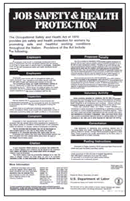
OSHA 2203

OSHA 3165
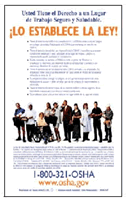
OSHA 3167
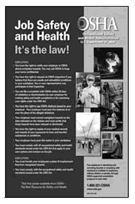
OSHA 3165 (revised 2012)

OSHA 3167 (revised 2012)
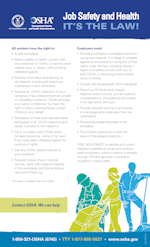
OSHA 3165 (revised 2015)
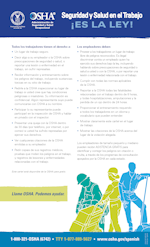
OSHA 3167 (revised 2015)
Although §1903.2 does not specify or require that the notice also must be posted in a foreign language (e.g., Spanish), OSHA encourages employers that have Spanish-speaking workers to post an additional notice in Spanish. Form 3167 is the Spanish version of 3165.
Posting OSHA Citations
Upon completing an inspection at your site, the inspector may issue citation(s) which will set a reasonable time for correction of the violation. When you receive the citation(s), OSHA regulation 1903.16 requires that you immediately post the citation at or near the place where the violation occurred. The citation should remain posted for three working days or until the unsafe condition has been corrected, whichever is later.
If the inspection results in no citations, you will receive a notice indicating that no citations were issued. Post this notice for three working days.
After receiving a citation, you must correct the unsafe condition. If it was a serious violation that you corrected, OSHA will issue a notice of correction. Once again, post this notice for three working days.
Annual Summary of Work-related Injuries and Illnesses—OSHA 300A
Unless your company is included in an exempted SIC, if you have 11 or more employees at any one time during the previous year, you are required to maintain a log of occupational injuries and illnesses. For this purpose, the OSHA 300 Log or an equivalent may be used. At the end of each calendar year, the contents of the 300 form are totaled and posted on the annual summary OSHA 300A.
An annual summary of occupational injuries and illnesses for each establishment must be posted. For the calendar, record work-related injuries and illnesses on the OSHA 300 Log and use this data to complete the OSHA 300A Summary. Enter the year covered, the company name, establishment name and address, annual average number of employees covered by the OSHA 300 Log, and the total hours worked by all employees covered by the OSHA Log. A company executive must certify that the information is correct and complete. Post the 300A from February 1 through April 30. If no injuries or illnesses occurred during the year, zeros must be entered on the totals line and the form must be posted for the same time period.
Right to Know Poster
The federal Hazard Communication standard does not require a notice to be posted concerning workers’ right to know about the hazardous substances in their workplace. However, a number of state worker right to know laws and regulations do require that a notice or sign be posted informing employees that additional information on toxic and hazardous substances in their workplace is available. Check with your local OSHA office to determine if your state requires posting of a right to know notice.
Minimum Wage Poster
Every employer employing any employees subject to the Act's minimum wage provisions shall post and keep posted a notice explaining the Act, as prescribed by the Wage and Hour Division, in conspicuous places in every establishment where such employees are employed so as to permit them to observe readily a copy. Any employer of employees to whom section 7 of the Act does not apply because of an exemption of broad application to an establishment may alter or modify the poster with a legible notation to show that the overtime provisions do not apply. For example: Overtime Provisions Not Applicable to Taxicab Drivers (section 13(b)(17)).
Notice to Workers With Disabilities Paid at Special Minimum Wages
Every employer having workers who are employed under special minimum wage certificates shall at all times display and make available to employees a poster as prescribed and supplied by the Administrator. The Administrator will make available, upon request, posters in other formats such as Braille or recorded tapes. Such a poster will explain, in general terms, the conditions under which special minimum wages may be paid and shall be posted in a conspicuous place on the employer's premises where it may be readily observed by the workers with disabilities, the parents and guardians of such workers, and other workers. Where an employer finds it inappropriate to post such a notice, this requirement may be satisfied by providing the poster directly to all employees subject to its terms.
Polygraph Protection Poster
Every employer subject to the Employee Polygraph Protection Act shall post and keep posted on its premises a notice explaining the Act, as prescribed by the Secretary. Such notice must be posted in a prominent and conspicuous place in every establishment of the employer where it can readily be observed by employees and applicants for employment.
Family and Medical Leave Act (FMLA) Employer Notice Requirements
Every employer covered by the FMLA is required to post and keep posted on its premises, in conspicuous places where employees are employed, a notice explaining the Act’s provisions and providing information concerning the procedures for filing complaints of violations of the Act with the Wage and Hour Division. The notice must be posted prominently where it can be readily seen by employees and applicants for employment. The poster and the text must be large enough to be easily read and contain fully legible text. Electronic posting is sufficient to meet this posting requirement as long as it otherwise meets the requirements of §825.300. An employer that willfully violates the posting requirement may be assessed a civil money penalty by the Wage and Hour Division not to exceed $110 for each separate offense. Covered employers must post this general notice even if no employees are eligible for FMLA leave.
If an FMLA-covered employer has any eligible employees, it shall also provide this general notice to each employee by including the notice in employee handbooks or other written guidance to employees concerning employee benefits or leave rights, if such written materials exist, or by distributing a copy of the general notice to each new employee upon hiring. In either case, distribution may be accomplished electronically. To meet these requirements, employers may duplicate the text of the Department of Labor’s prototype notice (WHD Publication 1420) or may use another format so long as the information provided includes, at a minimum, all of the information contained in that notice. Where an employer’s workforce is comprised of a significant portion of workers who are not literate in English, the employer shall provide the general notice in a language in which the employees are literate. Employers furnishing FMLA notices to sensory-impaired individuals must also comply with all applicable requirements under Federal or State law.
Editor’s Note: Effective March 8, 2013, all covered employers must post a revised FMLA poster on their premises in a conspicuous place seen by applicants and employees. In general, covered employers include all public and private employers with 50 or more employees. The new poster includes, among other changes, a broadened definition of the term “veteran” to include a veteran discharged within the past five years.
Equal Employment is the Law Poster
29 CFR 1601.30 and 29 CFR 1627.10, and 29 CFR 1635.10(c)
The Equal Employment Opportunity Commission (EEOC) requires covered employers to post notices describing the federal laws prohibiting job discrimination based on race, color, sex, national origin, religion, age, equal pay, disability, and genetic information. Private employers are covered by the laws enforced by the EEOC if they have 15 or more employees who worked for the employer for at least 20 calendar weeks (in this year or last). These employers have an obligation, under Title VII of the Civil Rights Act, the Equal Pay Act, the Americans with Disabilities Act (ADA), and the Genetic Information Nondiscrimination Act (GINA), to post and keep posted in conspicuous places on its premises notices in an accessible format, to be prepared or approved by the EEOC, describing the applicable provisions of Title VII, the Equal Pay Act, the ADA, and GINA. Such a notice must be posted in prominent and accessible places where notices to employees, applicants for employment, and union members are customarily maintained.
It is our understanding that the notices under §1601.30, §1627.10, and §1635.10 are provided for in a single “Equal Employment Opportunity is the Law” poster. The EEOC poster explains an applicant’s or employee’s rights concerning discrimination.
Certain federal contractors also must post the Equal Employment Opportunity is the Law poster. Employers with federal contracts or subcontracts or federally assisted construction contracts of $10,000 or more and financial institutions which are issuing and paying agents for U.S. savings bonds must display the poster under Executive Order 11246, the Vietnam Era Veterans' Readjustment Assistance Act, and Section 503 of the Rehabilitation Act of 1973.
Your Rights Under USERRA Notice
Appendix to 20 CFR 1002
The Veterans Benefits Improvement Act of 2004 (VBIA), Public Law 108-454 (December 10, 2004), amended the provisions of the Uniformed Services Employment and Reemployment Rights Act of 1994 (USERRA), to add 38 U.S.C. 4334. Section 4334 requires that, effective March 10, 2005, each employer provide to persons entitled to rights and benefits under Chapter 43 of USERRA a notice of the rights, benefits, and obligations of such persons and such employers under this Chapter. The posting requirement may be met by the posting of the notice where employers customarily place notices for employees. Employers may also provide the full text of the notice via direct handling, mailing, or e-mail. The text of the notice is provided at the Appendix to 20 CFR 1002, which was revised in an October 27, 2008, final rulemaking, effective on the same date.
Notice To Employees Working on Government Contracts (Service Contract Act Poster)
The contractor and any subcontractor under this contract shall notify each service employee commencing work on this contract of the minimum monetary wage and any fringe benefits required to be paid pursuant to this contract, or shall post the wage determination attached to this contract. The poster provided by the Department of Labor (Publication WH-1313) shall be posted in a prominent and accessible place at the worksite. Failure to comply with this requirement is a violation of Section 2(a)(4) of the Service Contract Act and of the contract.
Notice To All Employees Working on Federal or Federally Financed Construction Projects (Davis-Bacon Act Poster)
The wage determination (including any additional classification and wage rates) and the Davis-Bacon poster (WH-1321) must be posted at all times by the contractor and its subcontractors at the site of the work in a prominent and accessible place where it can be easily seen by the workers.
Notification of Employee Rights under the National Labor Relations Act (NLRA)
29 CFR 471
Federal contractors and subcontractors are required to display this poster informing employees of their rights under the National Labor Relations Act. It must be posted conspicuously in plants and offices where employees covered by the NLRA perform contract-related activity, including all places where notices to employees are customarily posted, both physically and electronically. Contractors must post an exact copy of the official notice.
Notice: Migrant and Seasonal Agricultural Worker Protection Act Poster
Each farm labor contractor, agricultural employer, and agricultural association which employs any migrant agricultural worker shall post (and maintain) in a conspicuous place at the place of employment a poster provided by the Secretary of Labor, which sets out the rights and protections for workers required under the Act.
This requirement applies to any person who owns or operates a farm, ranch, processing establishment, cannery, gin, packing shed, or nursery, or who produces or conditions seed, and who either recruits, solicits, hires, employs, furnishes, or transports one or more migrant or seasonal agricultural worker.
Equal Employment is the Law Poster
29 CFR 1601.30 and 29 CFR 1627.10, and 29 CFR 1635.10(c)
The Equal Employment Opportunity Commission (EEOC) requires covered employers to post notices describing the federal laws prohibiting job discrimination based on race, color, sex, national origin, religion, age, equal pay, disability, and genetic information. Private employers are covered by the laws enforced by the EEOC if they have 15 or more employees who worked for the employer for at least 20 calendar weeks (in this year or last). These employers have an obligation, under Title VII of the Civil Rights Act, the Equal Pay Act, the Americans with Disabilities Act (ADA), and the Genetic Information Nondiscrimination Act (GINA), to post and keep posted in conspicuous places on its premises notices in an accessible format, to be prepared or approved by the EEOC, describing the applicable provisions of Title VII, the Equal Pay Act, the ADA, and GINA. Such a notice must be posted in prominent and accessible places where notices to employees, applicants for employment, and union members are customarily maintained.
It is our understanding that the notices under §1601.30, §1627.10, and §1635.10 are provided for in a single “Equal Employment Opportunity is the Law” poster. The EEOC poster explains an applicant’s or employee’s rights concerning discrimination.
Your Rights Under USERRA Notice
Appendix to 20 CFR 1002
The Veterans Benefits Improvement Act of 2004 (VBIA), Public Law 108-454 (December 10, 2004), amended the provisions of the Uniformed Services Employment and Reemployment Rights Act of 1994 (USERRA), to add 38 U.S.C. 4334. Section 4334 requires that, effective March 10, 2005, each employer provide to persons entitled to rights and benefits under Chapter 43 of USERRA a notice of the rights, benefits, and obligations of such persons and such employers under this Chapter. The posting requirement may be met by the posting of the notice where employers customarily place notices for employees. Employers may also provide the full text of the notice via direct handling, mailing, or e-mail. The text of the notice is provided at the Appendix to 20 CFR 1002, which was revised in an October 27, 2008, final rulemaking, effective on the same date.
